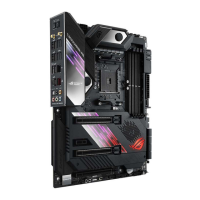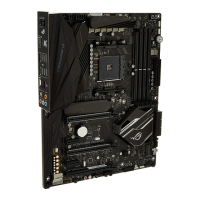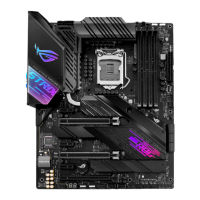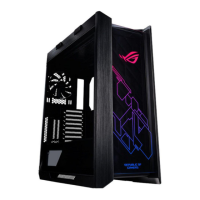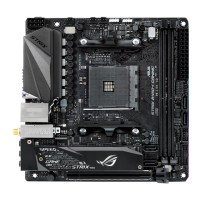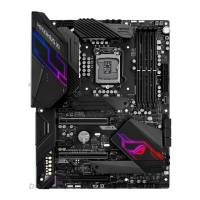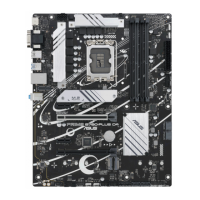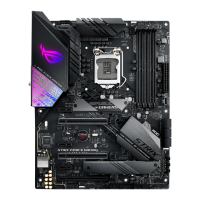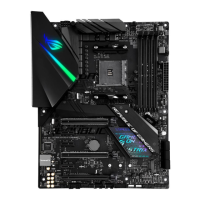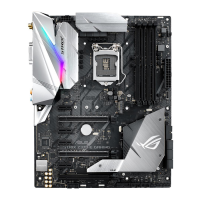
Do you have a question about the Asus ROG CROSSHAIR VIII IMPACT and is the answer not in the manual?
| Processor socket | Socket AM4 |
|---|---|
| Processor manufacturer | AMD |
| Compatible processor series | AMD Ryzen 3 2nd Gen, AMD Ryzen 3 3rd Gen, AMD Ryzen 5 2nd Gen, AMD Ryzen 5 3rd Gen, AMD Ryzen 7 2nd Gen, AMD Ryzen 7 3rd Gen, AMD Ryzen 9 3rd Gen |
| Maximum number of SMP processors | 1 |
| Audio chip | SupremeFX S1220A |
| Cooling type | Passive |
| Component for | Mini PC |
| Power source type | ATX |
| Motherboard chipset | AMD X570 |
| Audio output channels | 8.0 channels |
| Motherboard form factor | Mini DTX |
| Number of mounting holes | 4 |
| Windows operating systems supported | Windows 10 |
| Memory channels | Dual-channel |
| Memory slots type | DIMM |
| Unbuffered memory | Yes |
| Number of memory slots | 2 |
| Supported memory types | DDR4-SDRAM |
| Maximum internal memory | 64 GB |
| Supported memory clock speeds | 2133, 2400, 2666, 2800, 2933, 3000, 3200, 3400, 3466, 3600, 3733, 3866, 4000, 4133, 4266, 4400, 4600, 4800 MHz |
| Supported memory module capacities | 4GB, 8GB, 16GB, 32GB |
| RAID levels | 0, 1, 10 |
| Supported storage drive types | HDD & SSD |
| Supported storage drive interfaces | SATA III |
| Weight | 850 g |
| HDD size | 2.5/3.5 \ |
| Parallel processing technology support | - |
| Number of SATA II connectors | 0 |
| USB 2.0 ports quantity | USB 2.0 ports have a data transmission speed of 480 Mbps, and are backwards compatible with USB 1.1 ports. You can connect all kinds of peripheral devices to them. |
| USB 3.2 Gen 2 (3.1 Gen 2) Type-A ports quantity | 8 |
| LAN controller | Intel® I211-AT |
| Wi-Fi standards | 802.11a, 802.11b, 802.11g, Wi-Fi 4 (802.11n), Wi-Fi 5 (802.11ac) |
| Bluetooth version | 5.0 |
| Ethernet interface type | 10 Gigabit Ethernet, Fast Ethernet, Gigabit Ethernet |
| BIOS type | UEFI AMI |
| ACPI version | 6.2 |
| BIOS memory size | 256 Mbit |
| System Management BIOS (SMBIOS) version | 3.2 |
| Harmonized System (HS) code | 84733020 |
| Depth | 170 mm |
|---|---|
| Width | 203 mm |
| Height | 82 mm |
Safety precautions related to electrical hazards during installation and operation.
Precautions for safe handling and operation of the motherboard and its components.
Explains the structure and content of the user guide chapters.
Lists resources for additional product information and updates.
Explains symbols and text formatting conventions used for clarity.
Details CPU socket type, compatible processors, and chipset.
Lists memory specifications and PCIe slot configurations.
Details storage interfaces, LAN, Wi-Fi, and Bluetooth specifications.
Details audio codec, features, and USB port specifications.
Highlights proprietary ROG features and software.
Details BIOS features, hardware features, and Q-Design.
Lists and describes the ports on the rear input/output panel.
Details various internal headers and connectors on the motherboard.
Information on BIOS, system management, software, and dimensions.
Lists all items included in the motherboard package.
Lists tools and components needed for installation.
Important precautions before installing components or changing settings.
Identifies and locates key components and connectors on the motherboard.
Details specific component locations like CPU socket, DIMM slots, and connectors.
Describes the AM4 socket and CPU installation guidelines.
Explains DDR4 DIMM slots and memory module installation.
Details memory installation, capacity, and compatibility advice.
Details the PCIe x16 slot for expansion cards.
Explains PCIe lane configurations for different CPU generations.
Describes the function and location of onboard buttons like Power and Reset.
Details Safe Boot and ReTry buttons for overclocking and stability.
Details the button to clear BIOS settings, often for overclocking issues.
Describes onboard switches and jumpers like Slow Mode and LN2 Mode.
Explains the purpose of onboard LEDs for diagnostics and status.
Details the 8-pin power LED and the Q-Code error LED.
Details the SATA 6Gb/s connectors for storage devices.
Describes the SO-DIMM2 and M.2 slots for SSD installation.
Details the M.2 slots for M.2 SSD installation.
Describes the connectors for audio cards and front panel audio.
Details the connectors for USB 3.2 Gen 2 and Gen 1 ports.
Details the connector for USB 2.0 ports.
Explains connectors for system fans and water pumps.
Details connectors for water cooling and thermal sensors.
Details the ATX power connectors for the motherboard.
Explains the connector for chassis controls and LEDs.
Details the connector for RGB LED strips.
Describes the connector for addressable RGB LED strips.
Explains the connectors for the heatsink and PCH fans.
Describes connectors for Node devices and the CMOS battery.
Guides the user through the initial PC assembly process.
Step-by-step instructions for installing the CPU.
Instructions for installing the CPU heatsink and fan assembly.
Guides the installation of an All-In-One liquid cooler.
Steps to mount the motherboard into the PC chassis.
Step-by-step guide for installing memory modules.
Guides the connection of the ATX power supply and SATA storage devices.
Connects front panel components like USB and audio.
Instructions for installing PCIe x16 expansion cards.
Guides the installation of M.2 SSDs into M.2_1 socket.
Guides the installation of M.2 SSDs into M.2_2 socket.
Instructions for connecting the Wi-Fi antenna.
Introduces utilities for updating the system BIOS.
Details the process of updating BIOS using USB BIOS Flashback.
Covers rear panel I/O port connections and definitions.
Illustrates audio connections for headphones, mics, and speakers.
Guides on the initial system power-on procedure and checks.
Instructions on how to properly shut down the system.
Introduces the ASUS UEFI BIOS and its purpose.
Explains how to enter and navigate the BIOS setup program.
Introduces the Advanced Mode for detailed BIOS configuration.
Explains menu items, submenus, and shortcuts like My Favorites, Q-Fan, EZ Tuning.
Explains search, AURA control, help, configuration fields, and hotkeys.
Overview of basic system info and quick settings.
Detailed guide on setting fan profiles and manual configuration.
Step-by-step instructions for manual fan speed adjustment.
Wizard for easy CPU and DRAM overclocking.
Personalizable space for saving and accessing favorite BIOS items.
Overview of system info and basic settings, plus security options.
Access to overclocking-related settings.
Settings for Ai Overclock Tuner, BCLK, Memory Frequency, and TPU.
Access to advanced CPU and system device settings.
Configures SATA ports and mode (AHCI/RAID).
Configures various onboard devices and PCIe lanes.
Manages USB-related features and port settings.
Displays system temperature, power status, and fan settings.
Guides on fan tuning and water pump control.
Configures system boot options and priorities.
Access to special function utilities.
Utility for updating BIOS via USB or Internet.
Cleans SSDs to restore factory performance.
Stores and loads multiple BIOS setting profiles.
Options for saving, discarding, or loading default BIOS settings.
General advice and utilities for updating the BIOS.
Utility to restore BIOS from corruption.
Explains RAID support and configurations available.
Defines different RAID levels like RAID 0, 1, and 10.
Lists diagnostic Q-Codes and their meanings.
Lists ACPI/ASL checkpoints for system states.
Contains FCC compliance, RF exposure, and regional warnings.
Compliance statements for Canada, Japan, and Korea.
Declares compliance with EU directives and lists country restrictions.
Table showing output power for WiFi and Bluetooth.
Lists contact details for ASUS technical support globally.
